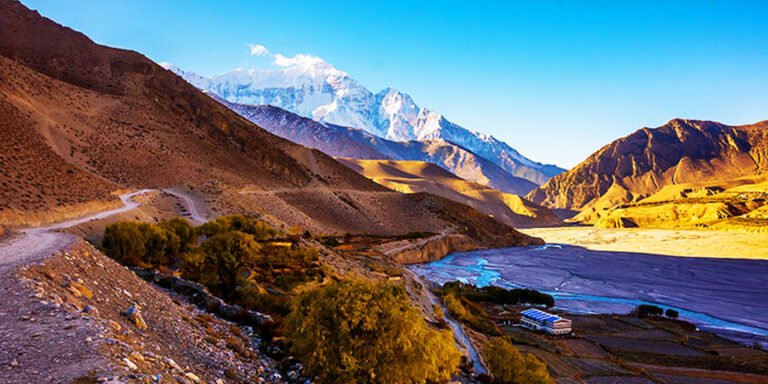The Mustang region of Nepal, often referred to as the “Last Forbidden Kingdom,” offers a rare glimpse into a remote and preserved Himalayan culture and landscape. Nestled in the rain shadow of the Annapurna and Dhaulagiri ranges, Mustang is a land of dramatic cliffs, ancient caves, and wind-eroded canyons that differ starkly from the lush green trails of other popular treks in Nepal. The Mustang Trekking experience is not just a hike—it’s a cultural and spiritual odyssey into the heart of Tibetan Buddhism and Himalayan mysticism.

A Distinctive Landscape
Mustang’s landscape is unique among Nepal’s trekking regions. The barren, desert-like terrain is shaped by powerful winds and centuries of erosion, creating striking rock formations and deep gorges. The trail passes through vibrant ochre-colored cliffs, hidden caves, and high mountain plateaus, all set against the backdrop of snow-capped Himalayan peaks. Because of its location in a rain shadow, Mustang is ideal for trekking even during the summer monsoon months, when other parts of Nepal are drenched in rain.
Cultural Heritage and Spiritual Significance
What truly sets Mustang apart is its rich cultural heritage. The region was part of the ancient trade route between Nepal and Tibet and has retained its strong Tibetan cultural identity. Upper Mustang Trek once a restricted kingdom, was only opened to outsiders in 1992, and its capital, Lo Manthang, remains a walled city of great historical and spiritual significance.
Trekkers will encounter centuries-old monasteries, chortens (stupas), mani walls, and traditional villages that have changed little over time. The people of Mustang practice Tibetan Buddhism and celebrate vibrant festivals such as Tiji, which symbolizes the victory of good over evil. Visiting during festival time offers a rare opportunity to witness sacred dances and rituals performed in traditional attire.
Trekking Itinerary and Requirements
The Mustang Trek typically takes 12 to 18 days, depending on the route and pace. Starting from Jomsom or Kagbeni, the trail leads through arid valleys and high passes, gradually ascending to Lo Manthang at 3,840 meters. While the altitude is moderate compared to other Himalayan treks, the terrain can be challenging due to strong winds and dry conditions.
A special Restricted Area Permit is required to enter Upper Mustang Overland Tour along with the Annapurna Conservation Area Permit (ACAP). Trekkers must travel with a licensed guide and in a group of at least two, in compliance with Nepali government regulations.
A Unique Trekking Experience
Mustang is ideal for trekkers looking to explore a less commercialized, culturally immersive, and geologically distinct region. Accommodations are available in local tea houses, offering basic yet comfortable lodging and authentic Nepali-Tibetan cuisine. The relative isolation of the area ensures a peaceful trekking experience away from the crowds found on more popular routes.
Conclusion
Trekking in Mustang is more than an adventure—it’s a journey into a lost world of ancient traditions, mystical landscapes, and timeless spirituality. For those seeking something beyond the ordinary, Mustang offers a deeply rewarding and unforgettable Himalayan experience.

